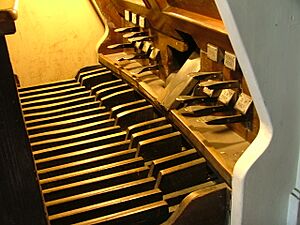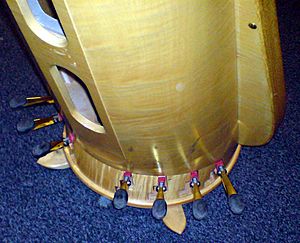Pedal (music) facts for kids
Pedals on musical instruments are special levers you push with your feet. They help control different parts of the instrument or add extra sounds. Many instruments use pedals in unique ways.
Contents
Piano Pedals
The piano usually has two or three pedals. These pedals let the player change the sound of the notes.
Sustain Pedal
The pedal on the right is called the sustain pedal. When you press it, the notes you play keep ringing out, even after you lift your fingers. This happens because the pedal lifts small felt pads called "dampers" off the strings. This allows the strings to vibrate freely and for a longer time. Sometimes, other strings will even start to vibrate along with the ones you played, which adds to the rich sound.
Soft Pedal
The pedal on the left makes the sound softer. It's sometimes called the "una corda" pedal, which means "one string" in Italian. On older pianos, this pedal made the hammers hit only one string instead of three, making the sound much quieter. On most modern pianos, it makes the hammers hit two strings instead of three, or it moves the hammers so they hit the strings more gently. On upright pianos, this pedal moves the hammers closer to the strings, so they don't hit them as hard.
Sostenuto Pedal
If a piano has a middle pedal, it's called the sostenuto pedal. This pedal is special because it only sustains the notes you are holding down when you press it. Any new notes you play after pressing it won't be sustained. This allows a musician to hold certain notes while playing other notes normally.
Organ Pedals
On pipe organs, there is a large pedalboard at the bottom. These pedals play notes just like the keys you play with your hands. An organ pedalboard usually has about two and a half octaves of notes. These notes are usually low sounds, like those found in the bass clef.
An organist has to learn to play with their feet at the same time as their hands. They use their toes or the heels of their shoes to press the pedals. It's even possible to play four notes at once with your feet, making a four-part chord. This is very difficult and is often found in some modern French organ music.
Harp Pedals
A concert harp has seven pedals. Each pedal can be in one of three positions: high, middle, or low. The strings of the harp are usually tuned to natural notes, like the white keys on a piano (C, D, E, F, G, A, B).
Each pedal changes one of the letter-named notes (like all the C's or all the D's) by one semitone (half step) higher or lower. For example, the pedal on the left changes all the D notes. If the pedal is in the highest position, all D's become D flat. If it's in the lowest position, all D's become D sharp. The pedals, from left to right, control the D's, C's, B's, E's, F's, G's, and A's.
Timpani Pedals
Pedal timpani are large drums that have a pedal to change their sound. This pedal can tighten or loosen the drumhead. When the drumhead is tightened, the note goes up in pitch. When it's loosened, the note goes down.
This type of pedal is a fairly new invention. Composers from the Classical music period (like Mozart or Beethoven) did not have pedal timpani. Their timpani had to be tuned by hand using small taps around the side of the drum. Later composers, like Béla Bartók, wrote music specifically for pedal timpani, allowing for quick pitch changes during a performance.
Harpsichord Pedals
Modern harpsichords often have pedals that change the sound. These pedals work in a similar way to the "stops" on an organ, which change the instrument's tone or loudness. In older harpsichords, musicians would usually change the sound by pushing or pulling small levers called "hand stops" directly on the instrument.
Related pages





